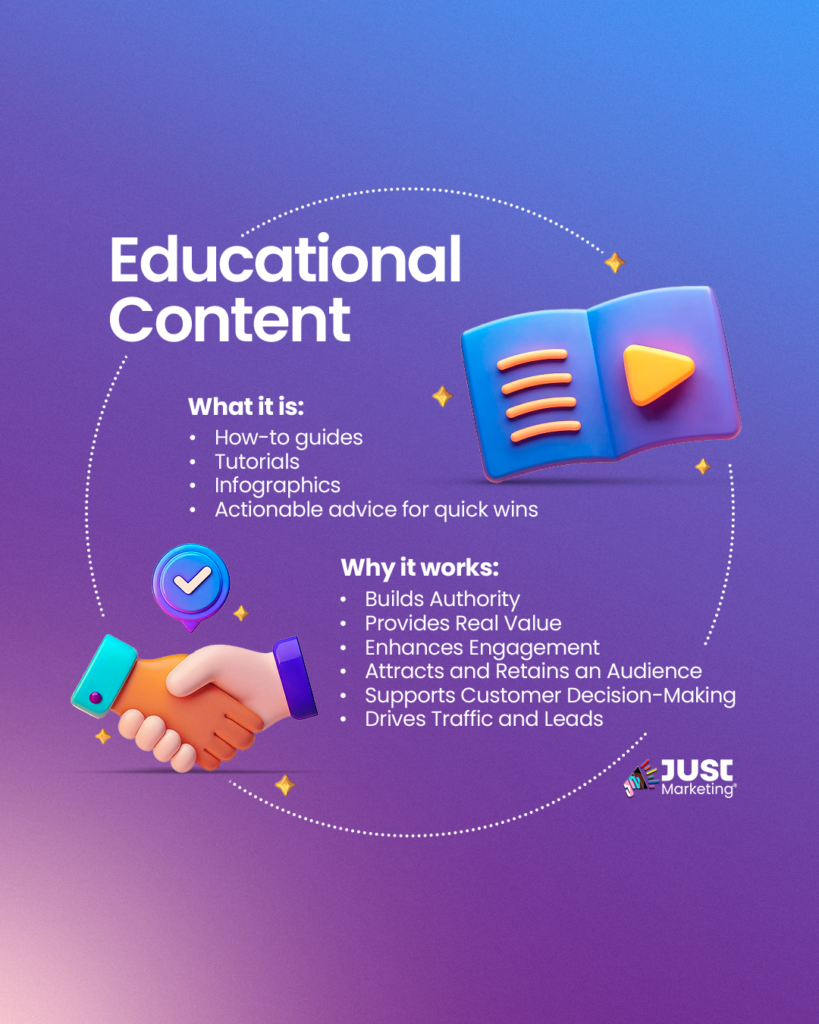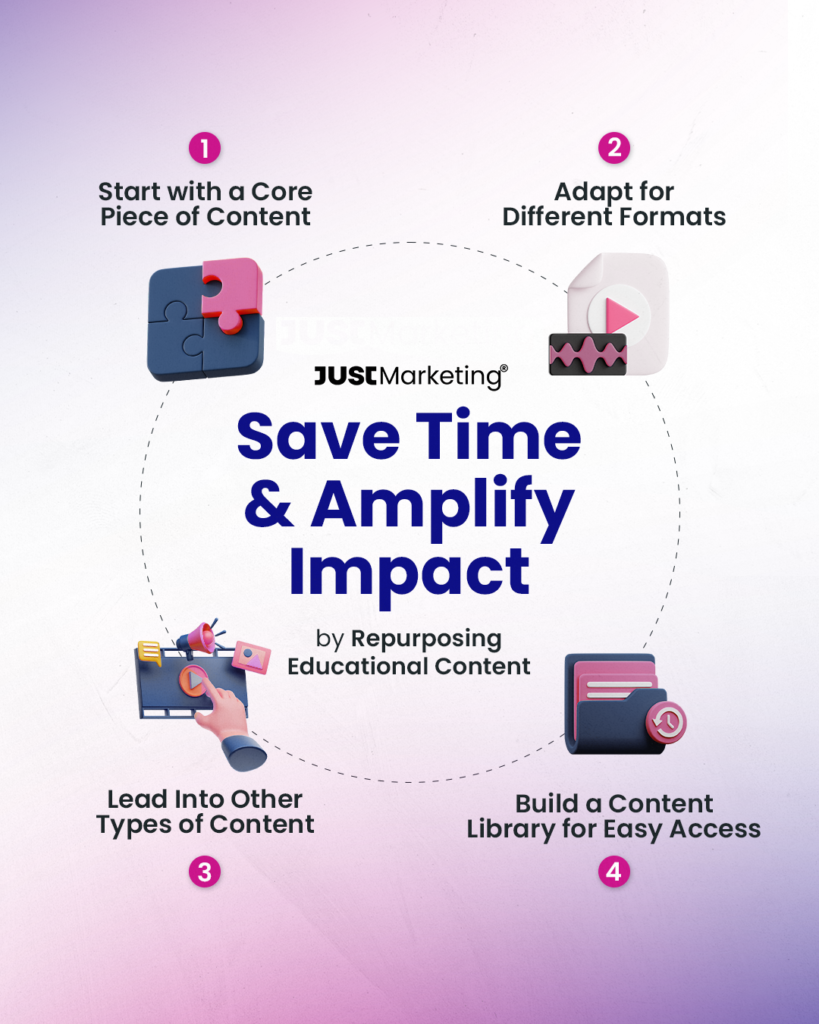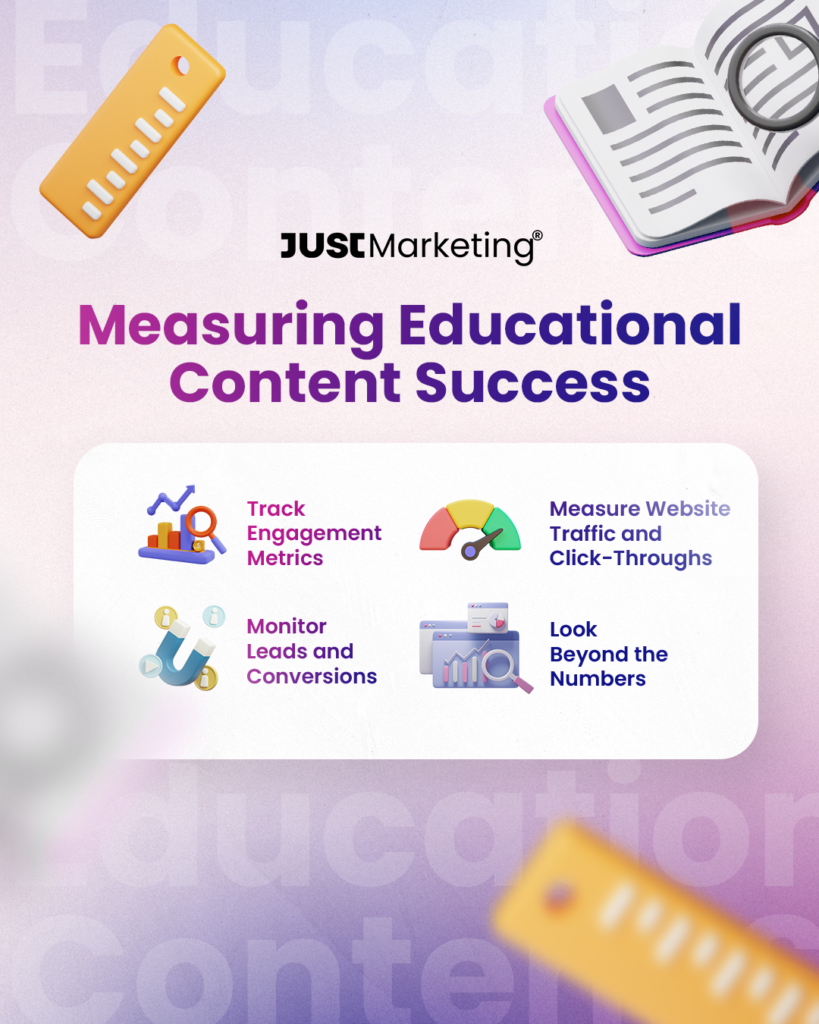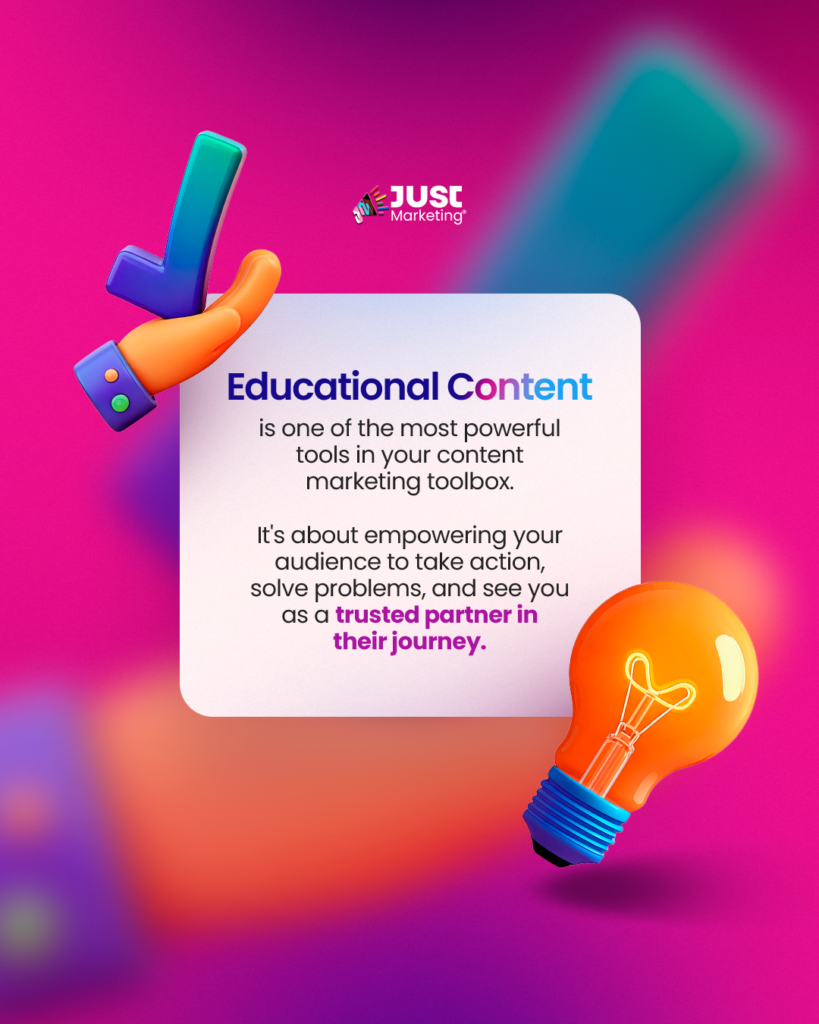That Builds Trust and Provides Value
What if your content could solve problems for your audience, position you as the go-to expert in your niche, and make their lives easier today?
Here’s the truth: educational content is one of the most powerful tools in your content marketing toolbox. It teaches, inspires, and supports your audience while simultaneously building trust and credibility. When done right, it’s not about overwhelming your audience with too much information or making them reliant on your expertise—it’s about empowering them to solve their own challenges and take meaningful action.
By the end of this post, you’ll understand how to create, plan, and analyze educational content that aligns with your values and connects authentically with your audience. Get ready to transform your content strategy and make a lasting impact.
What Is Educational Content?

Educational content is all about teaching or informing your audience in a way that helps them solve a problem, learn something new, or make an informed decision. At its core, educational content empowers your audience by providing real value—and when you consistently deliver this value, you establish yourself as a trusted authority in your niche.
This type of content can take many forms, such as:
- How-to guides or tutorials: Step-by-step instructions to tackle a challenge.
- Infographics: Visually engaging summaries of complex ideas.
- Webinars or workshops: Interactive sessions to deep-dive into key topics.
- Social media tips and carousels: Bite-sized, actionable advice for quick wins.
Why does educational content work so well?
- It Builds Authority: Sharing your expertise demonstrates that you know your stuff, positioning you as the go-to person in your field.
- It Provides Real Value: When your audience feels supported and empowered, they’re more likely to trust and engage with your brand.
- It Enhances Engagement: Content that teaches and inspires sparks conversations, shares, and saves.
- It Attracts and Retains an Audience: By solving problems and addressing questions, you’ll naturally draw in the right people—and keep them coming back.
- It Supports Customer Decision-Making: Helping your audience understand their options makes them more confident in choosing your products or services.
- It Drives Traffic and Leads: Educational content often leads readers to explore your website, download resources, or join your email list, turning curiosity into connection.
From an ethical perspective, educational content isn’t about creating dependency or overwhelming your audience with jargon. Instead, it’s a tool to empower them. Think of it as planting seeds: when you help your audience grow their knowledge, they’re more likely to trust and invest in you when they’re ready for additional support.
Whether you’re sharing how-to tips, diving into industry trends, or answering common questions, educational content has the potential to be a game-changer in your content marketing strategy. It’s not just about teaching; it’s about inspiring and connecting authentically.
How to Plan Educational Content

Creating impactful educational content starts with a solid plan. By understanding your audience’s needs, aligning with your expertise, and strategically choosing topics, you can produce content that resonates, empowers, and drives meaningful engagement.
Step 1: Identify Your Audience’s Challenges (aka Pain Points)
The first step in planning educational content is understanding the challenges your audience faces. What keeps them up at night? What questions do they ask repeatedly? These are the areas where your content can provide real value.
- How to discover their challenges:
- Conduct audience research through surveys or polls.
- Keep a running list of FAQs from your clients.
- Pay attention to comments or DMs on social media.
- Examples:
- Challenge: Struggling clients lack clarity on goal-setting.
Content Idea: The 5-Step Goal-Setting Framework Every Coach Needs to Share with Clients. - Challenge: Businesses struggle with client retention.
Content Idea: How to Create a Client Onboarding Process That Builds Loyalty from Day One. - Challenge: Clients aren’t seeing the value in regular communication.
Content Idea: The Weekly Check-In Template That Keeps Projects on Track and Clients Happy.
- Challenge: Struggling clients lack clarity on goal-setting.
When you solve a problem your audience cares about, your content becomes indispensable.
Step 2: Align with Your Expertise
Educational content works best when it leverages your unique strengths and niche expertise. Focus on topics that showcase your skills and reflect the core values of your business.
- How to Align Your Expertise:
- List your top skills or areas of knowledge.
- Cross-reference those skills with your audience’s needs.
- Example:
- Business Coach Expertise: Helping small businesses grow sustainably.
Content Idea: 3 Low-Stress Systems to Streamline Your Business Operations and Reclaim Your Time. - DEI Consultant Expertise: Building inclusive workplace cultures.
Content Idea: The Inclusive Language Guide: 10 Phrases to Strengthen Workplace Communication. - Virtual Assistant Expertise: Managing schedules and productivity.
Content Idea: 5 Productivity Hacks to Help Your Clients Stay Organized and On Time.
- Business Coach Expertise: Helping small businesses grow sustainably.
By centering your expertise, you’ll attract an audience who aligns with your approach and is eager to learn from you.
Step 3: Create a Mix of Evergreen and Timely Topics
A balanced content strategy includes both evergreen and timely topics. This mix ensures your content remains relevant over time while addressing current trends and events.
- Evergreen Content: Timeless resources that remain valuable year-round.
- Examples:
- How to Use Hashtags for Small Business.
- How to Structure a Discovery Call That Converts Without Feeling Salesy.
- How to Audit Your Business Processes for Long-Term Growth.
- The Client Feedback Framework: How to Use Testimonials to Grow Your Business.
- Examples:
- Timely Content: Trend-focused resources tied to a moment in time.
- Examples:
- 2025 Social Media Best Practices.
- 2025 Trends Every Life Coach Needs to Know to Attract New Clients.
- How New Data Privacy Laws Will Impact Your Consulting Contracts in 2025.
- 3 Ways to Prep Your Business for Black Friday as a Service Provider.
- Examples:
Tip: Aim for a 70/30 mix—70% evergreen and 30% timely—to maximize the longevity of your content while staying up-to-date.
Pulling It All Together
With these three steps—identifying pain points, aligning with your expertise, and balancing evergreen and timely topics—you’ll have a clear roadmap for planning educational content that delivers real value. This process ensures you’re not just throwing content out into the void but creating intentional, impactful resources that your audience will appreciate.
Best Practices for Creating Educational Content

Once you’ve planned your educational content, the next step is to create resources that are engaging, actionable, and accessible. Here are some best practices to ensure your content resonates with your audience while reflecting your values.
Tip 1: Make It Actionable
Your audience should walk away from your content feeling empowered to take immediate action. Break down complex ideas into simple, clear steps they can implement right away.
- How to Apply This:
- Provide checklists, templates, or step-by-step instructions.
- Include examples that show how your audience can apply the content to their own situation.
- Example: If you’re a parenting coach, create a resource like “3 Easy Steps to Decrease Bedtime Battles Tonight.”
Pro Tip: End your content with a “next step” suggestion, such as completing a small task or downloading a related resource.
Tip 2: Break It Down
Dense or overly complicated content can overwhelm your audience. Make your content more digestible by breaking it into smaller, manageable pieces.
- How to Apply This:
- Use visuals like infographics or diagrams to simplify concepts.
- Write in short paragraphs and use bullet points to organize key takeaways.
- Example: A business coach could turn a blog post like “How to Scale Your Business in 12 Months” into:
- An infographic summarizing the 12-month roadmap.
- A carousel post for Instagram with one tip per slide.
- A webinar diving into each phase.
Pro Tip: Always prioritize clarity over jargon. Your goal is to make your audience feel confident and informed, not overwhelmed.
Tip 3: Make It Inclusive and Accessible
Educational content should serve as many people as possible, regardless of their background, abilities, or language proficiency.
- How to Apply This:
- Use plain, inclusive language that avoids jargon or complex terminology.
- Add accessibility features like captions on videos, alt text for images, and transcripts for audio content.
- Consider cultural and contextual differences when addressing topics.
- Example: A DEI consultant might create a guide like “5 Inclusive Team-Building Activities for Remote Teams” and ensure the examples apply to global teams with varying time zones and cultures.
Pro Tip: Test your content for readability using tools like Hemingway App and ensure it meets accessibility standards like WCAG – The Just Marketing Checklist is also a great resource that simplifies the process.
By following these best practices, your educational content will not only deliver value but also reflect your commitment to ethical, inclusive, and accessible marketing. When your audience feels supported and empowered by your content, they’ll naturally see you as a trusted expert—and they’ll keep coming back for more.
How to Repurpose Educational Content

Creating educational content takes time and effort, so why not maximize its impact? Repurposing allows you to transform one piece of content into multiple formats, reaching new audiences and extending its lifespan. Here’s how to do it effectively:
Step 1: Start with a Core Piece of Content
Choose a high-value piece of content as your foundation. This could be a blog post, podcast, webinar, or a video. From there, you can break it into smaller pieces or reformat it for different platforms.
- Example:
A business coach creates a blog post titled “How to Build a Morning Routine for Success.”- Repurpose into:
- An Instagram carousel with each slide showcasing one step.
- A YouTube video or Instagram Reel with quick tips from the blog.
- A LinkedIn article summarizing the blog with a professional tone.
- An email to your subscribers featuring the main takeaways.
- Repurpose into:
Pro Tip: Always include a call-to-action (CTA) in every format, such as directing readers to download a free resource or join your membership.
Step 2: Adapt for Different Formats
Each platform has unique strengths, so tailor your content to fit. Focus on the audience’s behavior and preferences on that channel.
- How to Adapt:
- Visual Formats: Turn how-to guides or tips into Instagram carousels or Pinterest graphics.
- Interactive Formats: Host a Q&A or webinar on the same topic.
- Bite-Sized Formats: Break a long article into a series of short social media posts.
- Example:
A DEI consultant publishes a guide on “Inclusive Leadership Practices.”- Repurpose into:
- A LinkedIn post highlighting three practices with commentary.
- A downloadable checklist for your website.
- A podcast episode discussing how to implement those practices.
- Repurpose into:
Pro Tip: Use Canva templates to streamline creating visual assets for repurposing.
Step 3: Use Educational Content to Lead Into Other Types
Repurposed educational content can serve as the gateway to other content types, such as promotional or engagement-focused pieces.
- How to Transition:
- Link educational content to a related free resource or product offer.
- Use a blog post to drive email list sign-ups with a compelling lead magnet.
- Turn FAQs into short videos that promote upcoming services or products.
- Example:
A virtual assistant shares a YouTube tutorial titled “How to Set Up Your Email Automation.”- At the end, include a CTA like: “Want to save time? Download my free email automation checklist!”
- Later, promote your email automation services in a follow-up email sequence.
Step 4: Build a Content Library for Easy Access
Repurposing isn’t a one-time activity—it’s an ongoing strategy. Keep track of your core content and how you’ve repurposed it so you can refresh and reuse it later.
- Example:
Store all your educational content in a tool like Trello or Airtable, categorizing it by topic and format. This makes it easy to revisit and repurpose as your audience grows or your business evolves.
Pro Tip: Schedule periodic audits of your content library to identify pieces that can be updated or reused.
Repurposing educational content not only saves you time but also amplifies your reach. By sharing your message across multiple formats and platforms, you’re ensuring it reaches the right people at the right time—without constantly reinventing the wheel.
Measuring Success

Creating educational content is only half the equation—you also need to evaluate how it’s performing. Tracking the right metrics will help you understand what resonates with your audience, refine your strategy, and maximize your impact. Here’s how to measure the success of your educational content:
Step 1: Track Engagement Metrics
Engagement is a key indicator of how well your content connects with your audience. High engagement means your audience finds value in what you’re sharing.
- What to Look For:
- Likes, comments, and shares on social media posts.
- Saves or pins (e.g., on Instagram or Pinterest).
- Direct messages or responses from your audience.
Pro Tip: Pay attention to qualitative feedback, such as comments or DMs, which can offer deeper insights than numbers alone.
Step 2: Measure Website Traffic and Click-Throughs
Educational content often directs your audience to your website or specific resources. Monitoring these metrics shows how effectively your content drives action.
- What to Look For:
- Website visits from content links.
- Click-through rates (CTRs) on CTAs.
- Time spent on the page (a higher duration means your content is engaging).
Pro Tip: Use tools like UTM codes to track where your traffic is coming from and refine your promotional strategy accordingly.
Step 3: Monitor Leads and Conversions
One of the main goals of educational content is to build trust and guide your audience toward taking the next step—whether that’s signing up for a resource, joining your email list, or purchasing a service.
- What to Look For:
- Number of downloads or sign-ups for free resources.
- Growth in email subscribers or leads generated.
- Conversion rates on offers linked to educational content.
Pro Tip: Pair your educational content with a strategic CTA to make it easy for your audience to take action.
Step 4: Look Beyond the Numbers
Metrics are important, but success isn’t just about data. Educational content builds relationships, trust, and goodwill over time. Sometimes, the most valuable feedback comes from personal interactions or long-term audience engagement.
- How to Measure Qualitative Success:
- Do you receive messages like, “Your post helped me solve this problem,” or, “I love how much I learn from your content”?
- Are clients or leads mentioning your content during consultations or calls?
- Are you building a community of engaged followers who resonate with your values?
Pro Tip: Keep a file of positive feedback or testimonials—it’s a great way to remind yourself of the impact you’re making, even if growth feels slow.
By measuring both quantitative and qualitative success, you’ll have a holistic view of how your educational content performs. Use these insights to double down on what works, refine what doesn’t, and continue creating content that empowers and inspires your audience.
Next Steps

Educational content is a game-changer for entrepreneurs who want to serve their audience, build trust, and establish authority. It’s not just about sharing what you know—it’s about empowering your audience to take action, solve problems, and see you as a trusted partner in their journey.
By creating content that is actionable, inclusive, and tailored to your audience’s needs, you can make a meaningful impact while growing your business. Remember: educational content doesn’t have to be overwhelming or complicated. Start small, focus on quality over quantity, and always prioritize value.
Choose one topic your audience struggles with and create a piece of educational content this week. Whether it’s a quick Instagram post with tips or a detailed blog, you’ll be taking a step toward building deeper connections with your audience.
If you’re looking for guidance and inspiration, join my Content Marketing Membership! With weekly prompts, resources, and a supportive community, you’ll have everything you need to show up consistently and confidently.
Check out the other blog posts in this series:
- What to Post on Social Media
- Showcase Credibility Content Without Feeling Like You’re Bragging
- Spark Meaningful Interactions and Relationships with Engaging Content
- Increase Your Income with Promotional Content That Doesn’t Feel Salesy
- Connect With Your Audience Authentically Through Holiday Content

